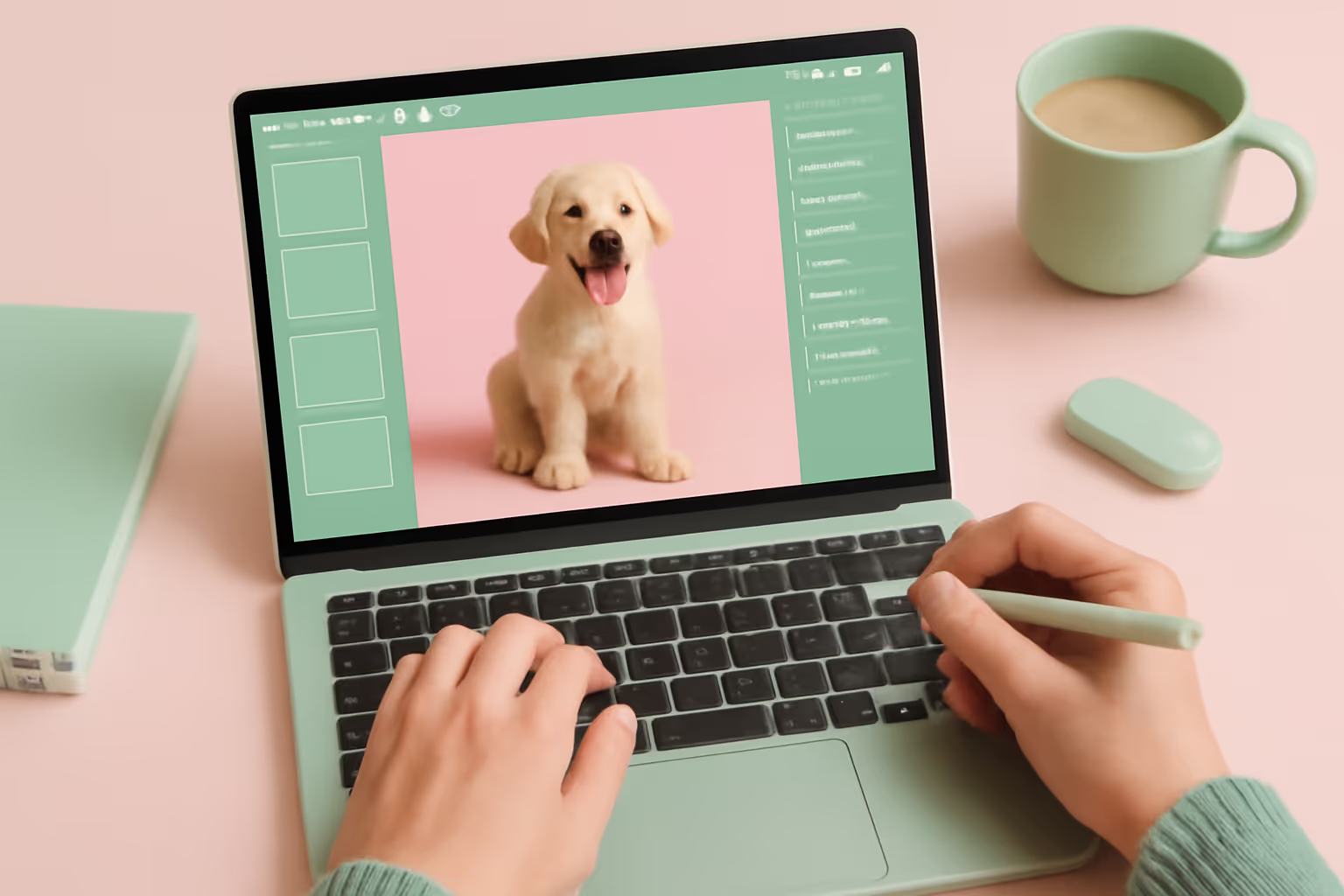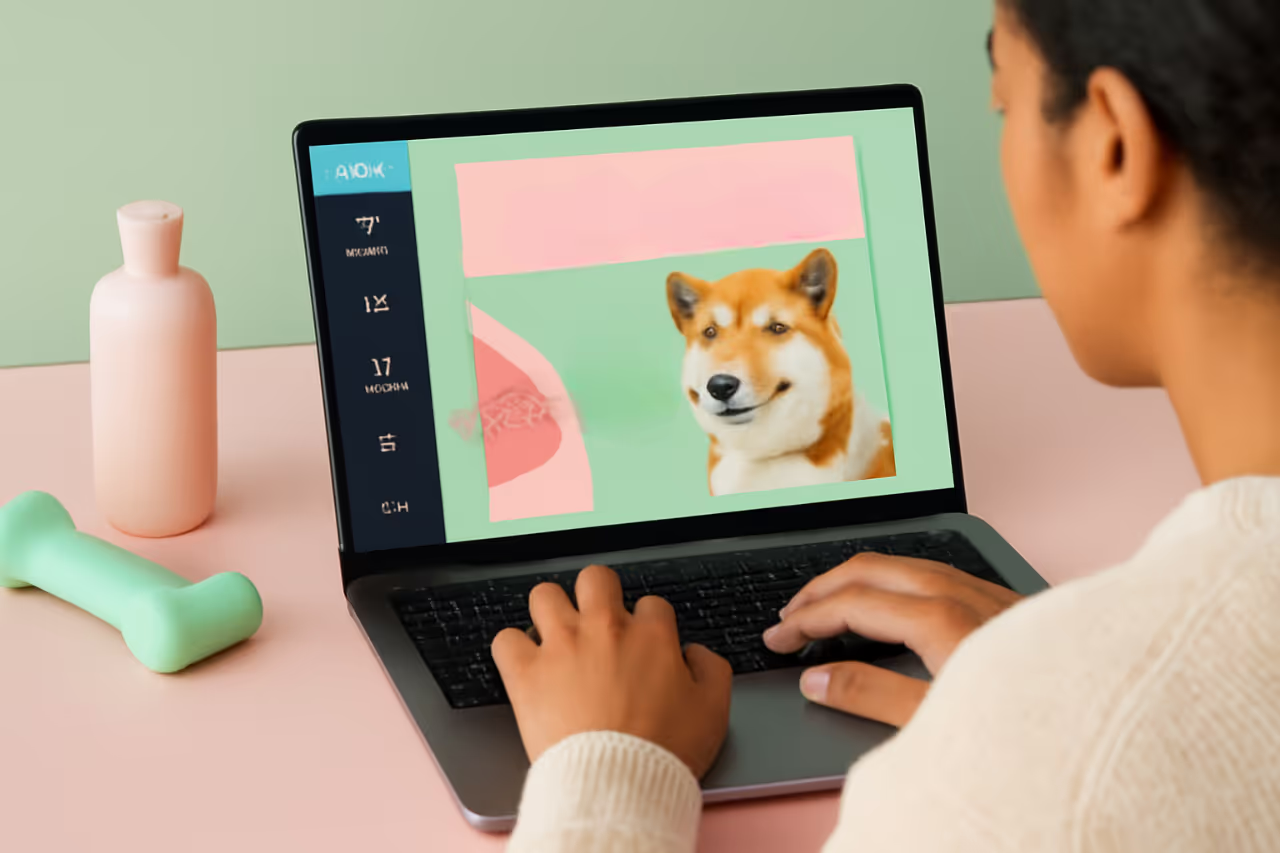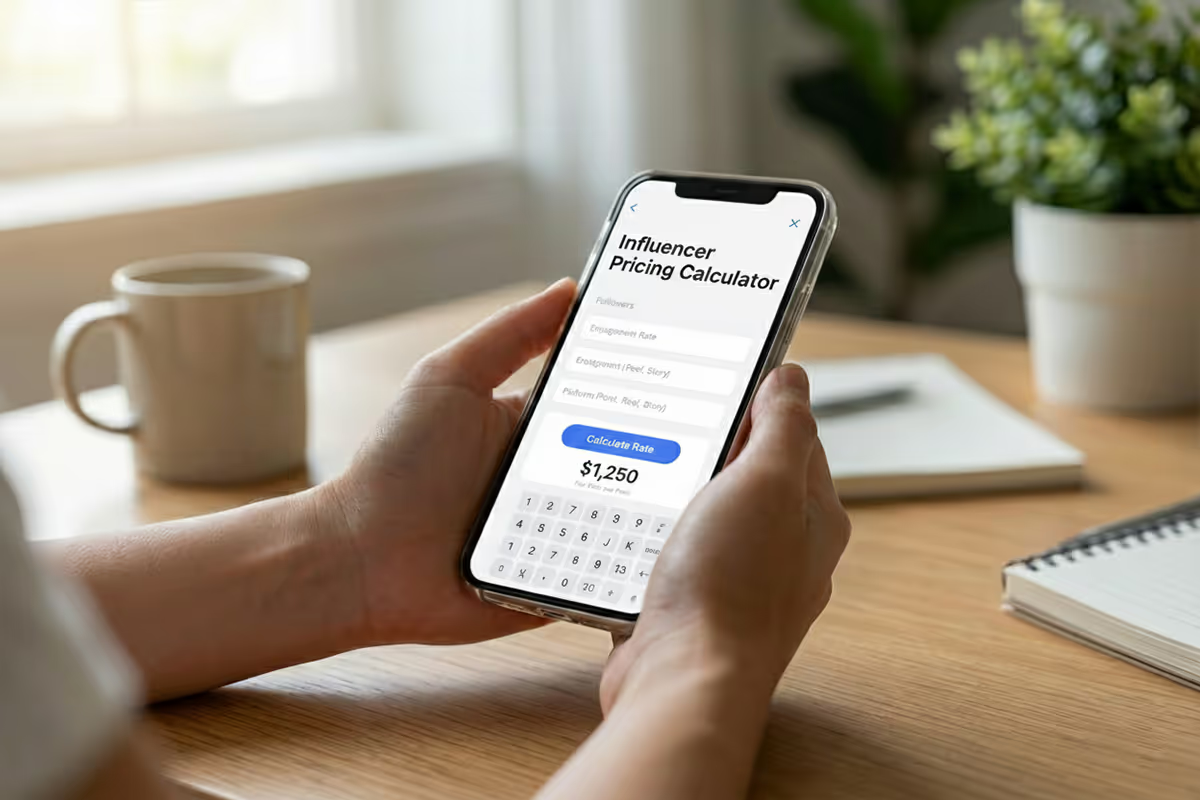How to Create a Good Logo for Your Pet Products Brand? A Complete Step Guide

The pet industry has exploded into a $261 billion global market, with U.S. consumers alone spending over $136 billion in 2023.
Standing out requires more than just quality products; a well-designed logo can increase brand recognition by up to 80%, making it a powerful tool in a crowded space.
If you're wondering how to create a good logo for your pet products brand, start with the fact that pet owners are deeply emotional buyers. Whether you're selling dog treats or grooming tools, your logo must reflect trust, care, and authenticity to spark that immediate connection with your audience.
Step-by-Step Guide to Creating a Good Pet Product Brand Logo
Your logo isn't just decoration; it’s your brand’s first impression. This framework helps you pick colors, fonts, and symbols that match your product focus and speak directly to your ideal pet parent.
Creating a successful logo for pet products requires a systematic approach that balances emotional appeal with practical functionality.
Define Your Brand Identity and Target Audience
Before touching any design tools, successful pet product logos start with clear brand positioning. Understanding the specific pet owner demographic guides every design decision from color choices to typography selection.
Key considerations for brand definition:
- Product category focus (health/wellness, toys, grooming, food)
- Price point positioning (budget-friendly, premium, luxury)
- Pet type specialization (dogs, cats, multi-pet households)
- Customer demographics (millennials, families, senior pet owners)
Choose Colors That Build Emotional Connection
Color psychology plays a crucial role in pet product branding. Warm colors like orange and yellow convey playfulness and energy, making them ideal for toy brands or active, et products.
Blue builds trust and reliability, essential for health-related items like supplements or medications. Green suggests natural, organic qualities that appeal to health-conscious pet owners.
Nes like brown and tan connect with the instincts of pets while appearing premium. Purple can work for luxury pet products, though it's less common in mainstream pet branding.
Red grabs attention but should be used carefully; it can suggest urgency or aggression, which might not align with the caring nature most pet brands want to project.

Select Typography That Builds Trust
Font selection can make or break a pet product logo. Script fonts often feel too feminine for brands targeting all pet owners, while overly bold sans-serif fonts can appear harsh or industrial. The sweet spot usually lies in clean, rounded fonts that feel approachable yet professional.
Custom lettering works particularly well for pet brands because it allows for playful modifications like extending the tail of a letter to mimic a pet's tail or adding paw prints as decorative elements.
However, readability must never be sacrificed for creativity. Pet owners need to quickly understand the brand name, especially when scanning crowded pet store shelves.
Incorporate Meaningful Symbolic Elements
The most memorable pet logos incorporate symbols that immediately communicate the brand's focus. Paw prints are obvious but effective when executed thoughtfully. Silhouettes of specific animals work well for specialized brands (cat-only or dog-only products), while more abstract pet-related shapes can appeal to multi-pet households.
Effective symbolic elements include:
- Paw prints (classic but requires unique execution)
- Animal silhouettes (breed-specific or generic)
- Pet-related objects (bones, leashes, food bowls)
- Heart shapes (emphasizing love and care)
- Natural elements (leaves, trees for organic positioning)
Hearts, bones, and pet-related objects like leashes or food bowls can work as secondary elements to dominate the design. The goal is to create instant recognition without being overly literal or childish.
Test and Refine Your Design Concepts
Logo development shouldn't end when the design feels complete. Smart brands test their logos with real customers and refine based on feedback before finalizing their choice. This process prevents costly mistakes and ensures the logo truly connects with the target market.
Showing logo concepts to friends and family provides limited value because they're not the target customers. Instead, pet product brands should test logos with actual pet owners who match their ideal customer profile. Online surveys, focus groups, or social media polls can generate more relevant insights.
Professional Design vs DIY: Choosing the Right Approach
The decision between hiring a professional designer and creating a logo independently depends on budget, timeline, and long-term brand goals. Each approach has distinct advantages and limitations that impact both immediate costs and future brand development.
When Professional Design Makes Sense
Established businesses or those planning significant marketing investments should strongly consider professional logo design. Experienced designers understand trademark considerations, scalability issues, and industry-specific requirements that amateur designers often miss.
Advantages of professional design:
- Multiple concepts and unlimited revisions
- Trademark search and legal considerations
- Scalability across all applications
- Strategic color and typography choices
- Industry-specific expertise
Professional designers also provide multiple concepts and revisions, ensuring the final logo works across all applications, from business cards to billboard advertisements. The investment typically ranges from $500 to $5,000, depending on the designer's experience and package inclusions.
DIY Logo Creation: Tools and Realistic Expectations
Budget-conscious entrepreneurs can create acceptable logos using platforms like Canva, LogoMaker, or Adobe Express. These tools offer pet-specific templates and symbols that can produce professional-looking results when used thoughtfully.
Popular DIY logo platforms:
- Canva (free and paid tiers)
- LogoMaker (template-based)
- Adobe Express (Adobe ecosystem)
- Looka (AI-powered suggestions)
The main limitations involve originality and legal protection. Template-based logos may appear similar to competitors' designs, and some platforms have restrictive licensing terms. For businesses testing market demand or operating with extremely limited budgets, DIY solutions can provide a starting point.

Common Logo Design Mistakes That Kill Pet Brand Success
Pet product entrepreneurs frequently make predictable logo mistakes that undermine their brand's effectiveness. Understanding these pitfalls helps avoid expensive redesigns and missed market opportunities.
Design Complexity That Confuses Customers
Many pet brand logos try to include too many elements: multiple animals, various symbols, and complex typography all competing for attention. Effective logos work at small sizes and reproduce clearly in single colors. Overly detailed designs lose impact when scaled down for social media profiles or product labels.
Signs of an overly complex logo:
- Multiple animals or symbols competing for attention
- Intricate details that disappear at small sizes
- More than three colors in the primary design
- Text that becomes unreadable when scaled down
The best pet logos follow the "glance test"; customers should immediately understand what the brand represents within two seconds of seeing the logo. Complexity works against this goal and creates confusion rather than connection.
Ignoring Real-World Application Requirements
Pet product logos appear across numerous applications with vastly different size requirements. Social media avatars might display the logo at 150x150 pixels, while trade show banners could showcase it at several feet wide. Logos that don't scale properly look unprofessional and damage brand credibility.
Vector-based designs solve most scalability issues, but the original concept must work at various sizes. Testing logo concepts at multiple sizes during the design phase prevents these problems.
Legal Protection and Trademark Considerations
Before finalizing any logo, conducting a thorough trademark search prevents legal complications down the road. The USPTO database shows registered trademarks, but comprehensive searches should also include pending applications and common law trademarks.
Pet product markets are crowded, and similar logos can create confusion or legal disputes. Even unintentional similarities to existing brands can result in expensive lawsuits or forced rebranding.
Investing in proper trademark searches and registration protects the brand investment and prevents future headaches.
Essential trademark steps:
- Search the USPTO database for existing registrations
- Check pending trademark applications
- Review common law trademarks in the pet industry
- Consider international trademark protection
- File your trademark application
Many successful pet brands also conduct image searches to identify visually similar logos that might not appear in trademark databases. This extra step catches potential conflicts that could create marketplace confusion even without legal violations.
Pro Tip: Many successful pet brands use logo variations tailored for different uses instead of one design everywhere. A detailed primary logo works for packaging, a simplified version fits social media, and a symbol-only mark suits small spaces. Brands like Purina and Pedigree use this approach to stay consistent and professional across all platforms.
Implementation Strategies for Maximum Brand Impact
Creating the perfect logo is only half the battle; implementing it consistently across all brand touchpoints determines its actual effectiveness. Pet product brands need systematic approaches to logo usage that build recognition and trust over time.
The logo should appear consistently across packaging, websites, social media, and marketing materials. Establishing clear brand guidelines prevents dilution of the logo's impact and ensures professional presentation regardless of who's handling the brand materials.

Digital applications require special consideration for pet product brands. The logo needs to work as a social media profile picture, website favicon, and email signature while maintaining legibility and impact. Mobile optimization is particularly crucial since many pet owners discover brands through smartphones.
Private-label brands in adjacent markets like private-label supplements or private-label skincare require consistent branding across all customer touchpoints, and pet product companies must ensure their logo works seamlessly across packaging, digital platforms, and marketing materials.
This consistency builds the recognition that drives repeat purchases and customer loyalty.
Physical packaging presents unique challenges for pet product logos. The design must remain visible and impactful on various package sizes and materials, from small treat pouches to large food bags.
Color reproduction can vary significantly across different printing processes, so testing the logo on actual packaging materials prevents unpleasant surprises.
Advanced Branding Insight: Leveraging Logo Motion for Emotional Impact
Adding subtle motion, like a tail wag or paw tap, to your pet product logo boosts emotional connection and memorability. Animated logos mimic pet behaviors, triggering warmth and trust more effectively than static images.
Use short loops on social media, websites, and ads to enhance brand recall without overwhelming viewers. This taps into behavioral psychology, creating a dynamic experience that resonates with pet owners.
Motion logos must scale well on all devices while keeping brand consistency. Test animations with your target audience to find what evokes the strongest response. Keep motions subtle to maintain professionalism and avoid distraction. Brands using motion add personality and stand out in the crowded pet market.
Time to Make Your Pet Product Stand Out
The pet products market rewards brands that connect with customers’ emotional bonds to their pets. A well-designed logo bridges product quality and customer trust, making it a vital long-term investment.
Whether using professional designers or DIY tools, the key is understanding your target audience and creating a logo that resonates with their values. Pet owners want confidence in the brands they choose, and a strong logo builds that trust from the start.
Testing logos with real pet owners, securing legal protection through trademark searches, and applying the design consistently maximizes its impact on growth. Getting this foundation right leads to better brand recognition, customer loyalty, and sales success in the competitive pet market.
FAQ
Related blogs

Influencer Pricing Calculator: Find Your Fair Rate for Posts, Reels & Stories
.avif)
How To Market Pet Products Through Storytelling: Win Attention, Build Trust, and Boost Sales Naturally
.avif)
How To Market Coffee To Gen Z: The High-Impact Blueprint Every Brand Needs
.avif)

